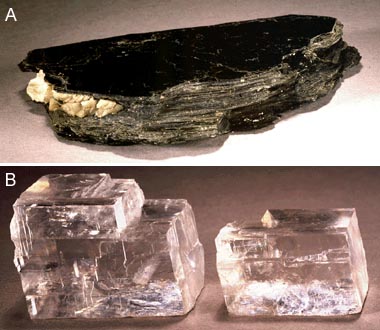
Download the answer sheet here
1. Learn about color in minerals at http://www.galleries.com/minerals/property/color.htm. Now look particularly at the mineral quartz at http://www.galleries.com/Quartz
A. Given that quartz has such an amazing variety of colors, why are they all considered to be the same mineral species?
B. Why is color of little use in identifying minerals?
C. Look at http://www.galleries.com/Mineral_Properties. What are some of the more useful diagnostic properties for identifying minerals?
2. Asbestos is a silicate mineral that has a reputation as being dangerous. Many countries including the United States, Canada, and France have outlawed its use in some products and have mandated that asbestos be removed from many buildings at great expense to the public. It is virtually insoluble and is used to provide tensile strength and moldability, thermal insulation, and resistance to fire, heat, and corrosion; inhalation of asbestos particles can cause asbestosis, pleural plaques, pleural fibrosis, pleural effusion, mesothelioma, and lung cancer. Is asbestos a single mineral? The Occupational Safety & Health Administration (OSHA) uses the following definition: "Asbestos" includes chrysotile, amosite, crocidolite, tremolite, anthophyllite, and actinolite.
A. Do all of these varieties belong to the same general silicate mineral group (For reference, a complete list of silicate groups is at http://www.galleries.com/Silicates)? If not, how many groups are represented and what are they? Go to http://www.mindat.org/index.php, click on Advanced Search and type in each mineral name. Then search on each variety to find out.
3. Mineral
cleavage is one of the principal physical properties used to identify minerals.
The two images below show examples of mineral cleavage.

A. Which choice best describes the type of cleavage shown in these two minerals?
1. Mineral A has poor cleavage, and Mineral B has excellent cleavage.
2. Mineral A has one direction of cleavage, and Mineral B has three directions of cleavage.
3. Mineral A has excellent cleavage, and Mineral B has poor cleavage.
4. Mineral A has two planes of cleavage, and Mineral B has one plane of cleavage.
4. Mineral Density
For identifying minerals, specific gravity is one of the more diagnostic features. Specific gravity is a measure of the density (r) of a mineral since it is defined as the ratio between the weight of a volume of the mineral and the weight of an equal volume of water. However, it is easy to confuse density with mass (m) or weight. Just because a large sample weighs more than a small sample does not mean that it is denser.
A. Use the following measurements to calculate the densities of ten mineral samples. Density can be calculated from the formula r= m/V
where r = density of an object in g/cm3
m = mass of the object in g
V = volume of the object in cm3
Sample |
Mineral |
Mass (g) |
Volume (cm3) |
Density (g/cm3) |
1 |
quartz |
10 |
3.7 |
|
2 |
quartz |
54.2 |
20 |
|
3 |
olivine |
40.5 |
11.9 |
|
4 |
olivine |
82.5 |
24.3 |
|
5 |
pyroxene |
5.2 |
1.6 |
|
6 |
pyroxene |
78.3 |
23.7 |
|
7 |
plagioclase |
10.0 |
3.7 |
|
8 |
plagioclase |
59.8 |
22.1 |
|
9 |
plagioclase |
91.3 |
33.8 |
|
10 |
galena |
55.6 |
7.3 |
B . Which two of these minerals would be hardest to tell apart based only on their densities?
C . Calculate the volume of quartz in a sample that weighs 2.34 kg.
D . The density of water is 1 g/cm3. Which of these minerals will sink the fastest in water?
E. A golden-colored cube is handed to you.
The person wants you to buy it for $100, saying that is a gold nugget. You pull out your old geology text and look up gold in the mineral table, and read that its density is 19.3 g/cm3. You measure the cube and find that it is 2 cm on each side, and weighs 40 g. What is its density? Is it gold?
Submit your answer sheet through the Assignments page on Blackboard by the due date announced in class.